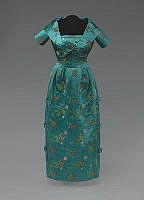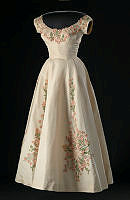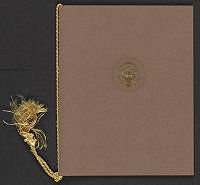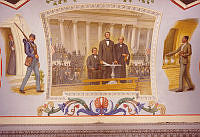Rubenstein Center Scholarship
Building the President's House with Enslaved Labor
James Hoban and Slavery
This article is part of the Slavery in the President’s Neighborhood initiative. Explore the Timeline
In several ways, James Hoban’s life resembles the classic immigrant success story. Born to a modest family in County Kilkenny, Ireland, Hoban studied at the Dublin Society School of Architectural Drawing before seeking greater opportunities abroad. He arrived in the new United States by 1785 and was settled in Charleston, South Carolina, by 1787, where he and his business partner Pierce Purcell worked on a variety of building projects. In other ways, Hoban’s experiences were very American. During his time in Charleston, Hoban purchased at least one enslaved person and learned the benefits of slave ownership—lessons he took with him to the new Federal City, where he amassed his fortune through public and private construction. Enslaved workers not only played a vital role in building the President’s House and the Capitol Building but also in Hoban’s rise to prominence and prosperity in early Washington, D.C.

This wax bas-relief on glass portrait is of James Hoban, the Irish-born architect who designed and built the White House. The portrait is attributed to John Christian Rauschner, a German sculptor who specialized in wax portraits. It was acquired for the White House collection by the White House Historical Association in 1976.
White House Collection/White House Historical AssociationWith any study that explores the experiences of enslaved communities, documentation is scant and incomplete. Most slave owners did not teach enslaved people how to read or write, and over time states passed laws that made these acts illegal; thus there are few surviving written sources. In addition to these general limitations, it is believed that all of Hoban’s personal papers were destroyed in a fire sometime during the 1880s. All that remains to document his life are those written in a professional capacity, which reveal little about Hoban’s views on slavery. However, surviving payroll and census records, advertisements, and newspapers do document Hoban’s relationship with slavery and its evolution during his lifetime. While their stories might be lost or incomplete, enslaved people were crucial to James Hoban’s success, much like the enslaved workers who built the President’s House were to the commissioners for the District of Columbia.
Hoban arrived in Charleston in early 1787. At some point, he purchased an enslaved man named Peter. According to a 1789 advertisement published in the City Gazette, Peter, who was “by trade a carpenter,” had “absented himself” shortly after the New Year. Hoban sought his immediate return and offered a reward of twenty shillings, warning that anyone who harbored or carried Peter away would be “dealt with according to law.”1 Two years later, Hoban was likely involved in work to prepare Charleston’s Exchange Building for the upcoming visit of the country’s most prominent citizen—President George Washington. While it is unclear whether Hoban met the president during his visit, Washington did meet with affluent citizens who later vouched for Hoban’s abilities as a builder and project manager.2 Click here to learn more about the enslaved households of President George Washington.

This January 17, 1789 advertisement by James Hoban seeks the return of Peter, an enslaved carpenter in Charleston, South Carolina.
City Gazette and Daily AdvertiserIn March 1792, the commissioners for the Federal District announced a design competition for the public buildings. In June, Hoban set off for Philadelphia to discuss his ideas with the president. The following month, Hoban’s plans for the President’s House were selected by the commissioners with Washington’s approval.3 The laying of the cornerstone took place on October 13, 1792, and construction picked up the following spring. However, these building projects quickly faced labor shortages as there were few free workers to be had: wages were low, and rations and housing for them were wholly inadequate. As the commissioners struggled to recruit laborers, it became increasingly clear that enslaved workers could help meet their demands. Hired out by local slave owners, enslaved people cleared the land, cut down trees, removed stumps, quarried and transported stone, and made thousands of bricks. There were also some enslaved craftsmen, and we know the names of four such men—Peter, Ben, Harry, and Daniel. Their names appear on a May 1795 carpenters’ payroll, and their wages were signed for by their owner James Hoban. In that month alone, Peter and Ben both worked twenty-eight days. Peter’s labor was valued at ten pounds and ten shillings, while Ben’s labor amounted to eight pounds and eight shillings. Daniel worked twenty-five days, worth six pounds and five shillings; Harry nine days, worth two pounds and five shillings.4 Perhaps Hoban permitted these men to keep small sums of their earnings, as this was not uncommon at the time; however, most slave owners simply pocketed the wages for themselves.

This 1795 payroll for the President's House lists four enslaved carpenters--Peter, Ben, Harry and Daniel--and their wages were signed for by James Hoban in the right column.
The National Archives and Records AdministrationWith the name “Peter” appearing in both the City Gazette advertisement and the carpenter payrolls, this Peter may have been one in the same. Hoban had purchased a man named Peter and trained him to work in his flourishing construction business in Charleston. Hoban may have had similar relationships with Ben, Daniel, and Harry, as they all worked at the President’s House. In late 1797, after white workers protested their wages and the pay of skilled Black workers, the commissioners ordered that “no Negro Carpenters or apprentices be hired at either of the public buildings.”5 While Hoban’s enslaved carpenters were banned from the site, he continued overseeing construction until 1800 when President John Adams moved into the White House. According to that year’s census, there were four enslaved people living in the Hoban household.6 While their age and sex were not recorded, these four residents may have been Peter, Ben, Daniel, and Harry. Click here to learn more about the households of President John Adams.
A few newspaper advertisements illuminate another important aspect of Hoban’s relationship with slavery, as he not only profited from enslaved labor but also sold enslaved people. In September 1804, Hoban published an ad in the Washington National Intelligencer to sell “A Valuable Strong active Negro Man” on behalf of the owner who was not “a resident of the city.” Parties interested in “the terms of sale” were instructed to contact “James Hoban, who on application will make them known.” Less than a year later, Hoban placed another advertisement in the same newspaper: “For Sale, A Negro Woman and her three Children, the eldest of whom is nine years of age, and the youngest three; the woman is about 33 years old. For further particulars enquire of Captain Hoban.”7 There are two scenarios that explain this advertisement: either Hoban was not their owner but was selling enslaved people on behalf of someone else, or he was their owner and looking to sell this woman and her young children. Either way, these advertisements suggest that Hoban not only purchased but also sold enslaved people.

This advertisement, dated January 30 and printed on February 4, 1805, seeks buyers for an enslaved woman and her three children. The seller is Captain James Hoban.
Washington National Intelligencer, genealogybank.comThe census records and other documentation reveal that Hoban continued to participate in the institution of slavery to the very end of his life. In 1820, there were twenty individuals in the Hoban household, nine of whom were enslaved.8 The nearly equal split between Black and white residents was not uncommon for the time, but the number of enslaved people was remarkably large as most households in Washington only had a few enslaved workers. This made Hoban one of the wealthiest slave-owning residents in Ward 2, but in a surprising twist by 1830 there were only two enslaved people and one free woman of color recorded at the Hoban residence.9 This change in the census records, along with Hoban’s signing of a petition advocating for the gradual abolition of slavery in the District, has led some scholars to argue that Hoban was opposed to slavery. This was not in fact the case.10

The 1820 census lists eleven white residents in the James Hoban household, along with nine enslaved people. This made Hoban one of the wealthiest slave owners in his ward.
The National Archives and Records Administration, Records of the Bureau of the Census, Record Group 29The petition, dated March 24, 1828, called upon members of Congress to address the slave trade in the nation’s capital, calling it “disgraceful in its character, and even more demoralizing in its influence.” It noted that “people are, without their consent, torn from their homes; husband and wife are frequently separated and sold into distant parts; children are taken from their parents, without regard to the ties of nature; and the most endearing bonds of affection are broken forever.” Slave traders in the city had developed a reputation for kidnapping free people of color and selling them into bondage, scenes that were “continually taking place among us, and lament our inability to prevent them.” While the signers recognized that the “sudden emancipation of the slaves in this District” would be rash, they requested Congress to pass legislation “declaring that all children of slaves, born in the District of Columbia after the fourth day of July, eighteen hundred and twenty-eight, shall be free at the age of twenty-five years; and that those laws, which authorize the selling of supposed runaways for their prison fees or maintenance, maybe repealed.”11 While Hoban’s signature on the document is an acknowledgement that slavery and the slave trade in Washington were reprehensible, this petition would have permitted slavery to continue for decades. For those enslaved prior to the date, they would remain in bondage for the rest of their lives—and for those born after July 4, 1828, they would be enslaved by law until 1853.

The 1830 census lists six white residents in the James Hoban household, along with two enslaved people and one free woman of color. This document had led some scholars to suggest that Hoban's slave owning had decreased from 1820 (nine) to 1830 (two) and therefore he was beginning to reject slavery. However, other records suggest that at least six enslaved people were not present for the 1830 census.
The National Archives and Records Administration, Records of the Bureau of the Census, Record Group 29Three-and-a-half years later, James Hoban died on December 8, 1831, but his will and testament provide more insight to his views on slavery. The following spring, the executors of Hoban’s estate, James Hoban Jr. and Thomas Carbery, placed multiple advertisements in the Daily National Intelligencer to sell two women, five men, and one young child: “These negroes were the property of the late captain James Hoban, who has directed, by his will, that they shall not be sold or taken out of the District.”12 The discrepancy between the 1830 census and these advertisements means that six enslaved people were not within the household when that census was taken, and based on the ages and the observation that some were “good house servants,” Hoban may have been hiring them out elsewhere. His request to keep these eight enslaved people within the District does suggest that Hoban did not want to deliberately separate family members from one another. However, this evidence challenges the idea that Hoban became uncomfortable with slavery toward the end of his life, as his ownership of people did not dramatically decline nor did he manumit any of his enslaved workers in his will.

This is the second page of James Hoban's will and testament, which explicitly states: "It is my will and desire that my slaves should not be sold out of the District of Columbia." Hoban did not free any of the enslaved people he owned upon his death.
The District of Columbia Probate Records, 1801–1930, Register of Wills, 1826–1837, 393–94.On June 8, 1792, President George Washington wrote the following in a letter to the Commissioners for the District of Columbia: "The bearer of this, Mr James Hoben, was strongly recommended to me by Colo. Laurens and sevral other Gentlemen of So. Carolinia when I was there last year, as a person who had made architecture his study, and was well qualified not only for planning or designing buildings, but to superintend the execution of them."13 Hoban's contemporaries were impressed by his architectural talents and managerial skills, so much so that they relayed these sentiments to President Washington. As an effective builder, this meant that Hoban was well-equipped to supervise both free and enslaved laborers, and likely his experiences as an architect, freemason, carpenter, and slave owner prepared him to manage such a workforce in the nation's capital. Ultimately, Hoban’s legacy as the architect of the White House is secure, but it is worth noting that it took many hands—free and enslaved, skilled and unskilled—to bring his vision to life.14

This advertisement, published frequently in spring 1832 by the executors of James Hoban's estate, list two women, one of whom has a young child, and five young men ranging in ages between twelve and twenty-eight for sale. These eight individuals suggest that the 1830 census was inaccurate, and that Hoban remained a consistent slave owner until his death in 1831.
Daily National Intelligencer/genealogybank.com









